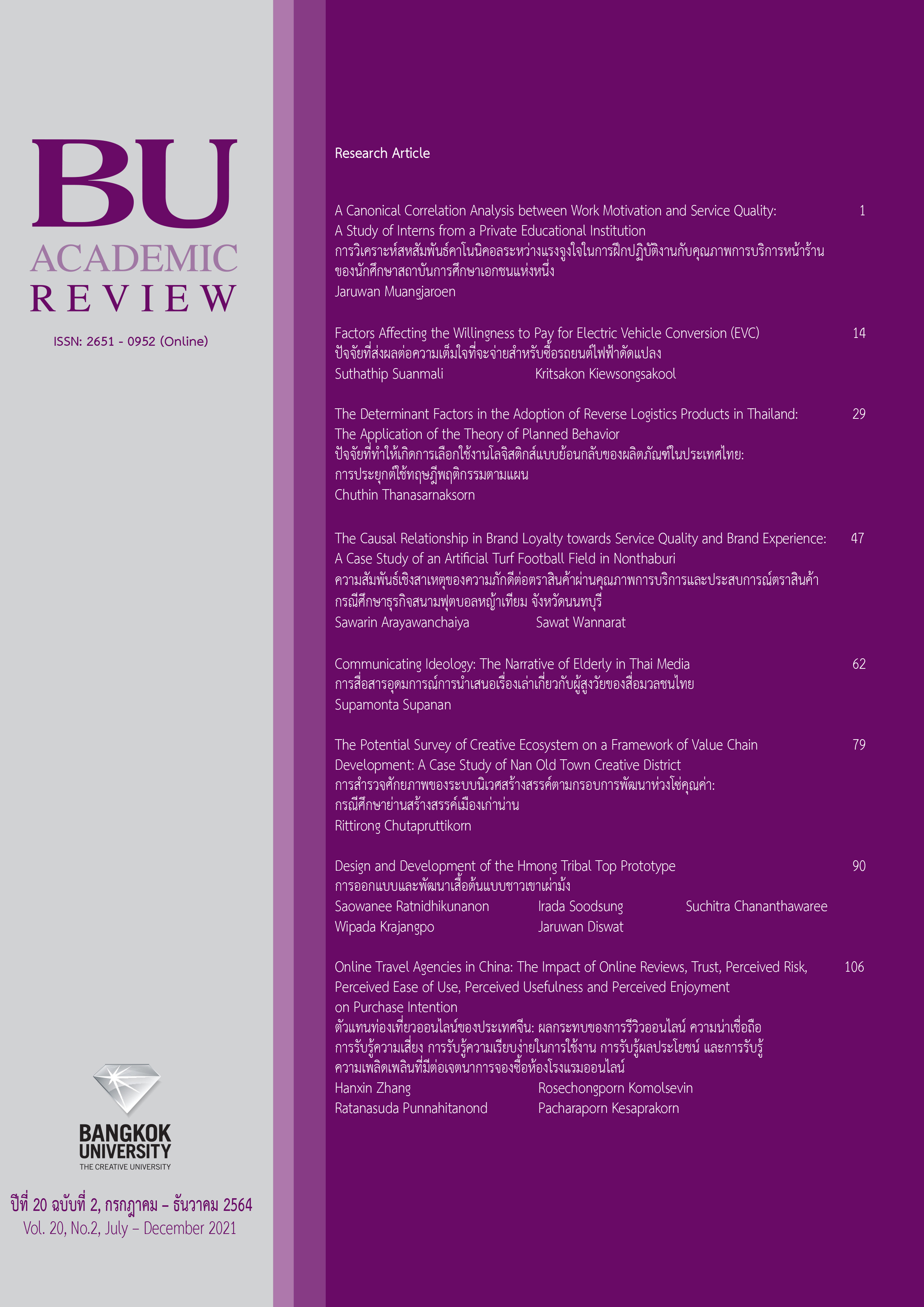The Potential Survey of Creative Ecosystem on a Framework of Value Chain Development: A Case Study of Nan Old Town Creative District
Main Article Content
Abstract
Nan Old Town” was recognized as a vital business district of its province for decades. However, the numbers of creative products were declined, when mode of production like craftsmanship was gradually replaced by an industrialized one. The concept of ‘creative district development’ is yet an attempt to revitalizing the economic role of this old commercial center. This research, therefore, explores the potential of creative ecosystems by assessing three assets: economy, place, and people. From interviews and focused-group discussions with networks of many sectors and mapping the district's assets, it was found that fashion and textile industries are the most outstanding creative enterprise. This district plays a key role in product distribution, but it lacks spaces to encourage creative thinking and production activities. Both are key elements that are able to add more value to those traditional products. Creative incubation areas and activities that support creative industries should be promoted in the Nan’s district development plan.
Article Details
The manuscript submitted for publication must be the original version, submitted only to this particular journal with no prior acceptance for publication elsewhere in other academic journals. The manuscript must also not violate the copyright issue by means of plagiarism.
References
AuthentiCity. (2008). Creative city: Planning framework a supporting document to the agenda for
prosperity: Prospectus for a great city. Toronto, USA: AuthentiCity.
Bednář, P., & Danko, L. (2020). Coworking spaces as a driver of the post-fordist city: A tool for building
a creative ecosystem. European Spatial Research and Policy, 27(1), 105-125.
Bureau of International Cooperation Ministry of Education Thailand. (n.d.). Khrōngkān khrư̄akhāi mư̄ang
sāngsan khō̜ng ʻongkān yūnētkō [UNESCO creative cities network - UCCN]. Retrieved August 1,
, from https://bic.moe.go.th/index.php/unesco-others-menu/unesco-menu/uccn-8-7-2562
Chunarom, S. (2001). Nǣothāng kānphatthanā phư̄nthī sāngsan: Kō̜ranī sưksā khrōngkān R.C.A.
[Development guideline for creative space: Case study R.C.A] (Master’s thesis, Thammasat
University).
Creative Economy Agency. (2020). Rāingān sarup phūbō̜rihān khrōngkān khrư̄akhāi yān sētthakit
sāngsan prathēt Thai yān sētthakit sāngsan mư̄ang kao Nān čhangwat Nān [Executive report:
Thailand creative district network (TCDN) Nan old town creative district]. Bangkok: Creative
Economy Agency.
Davies, D., Haywood, S., & Howe, A. (2004). Building a creative ecosystem: The young designers on
location project. International Journal of Art and Design Education, 23(3), 278-289.
Florida, R. (2002). The rise of the creative class and how it’s transforming work, leisure, community
and everyday life. New York, NY: Basic Books.
Harvey, D. (2001). The art of rent: Globalization and the commodification of culture (1st ed.). New York:
Routledge.
INTELI. (2011). Creative-based strategies in small and medium-sized cities: Guidelines for local
authorities. Portugal: Óbidos Municipality.
Lerdananpipat, S., & Thawepetch, P. (2015). Nǣothāng kānphatthanā kāiyaphāp khō̜ng chumchon hūa
wīang tai phān krabūankān mī sūan rūam khō̜ng sangkhom [Guidelines for physical
development of Hua Wiang Tai community through the social participatory process]. Built
Environment Inquiry Journal Faculty of Architecture Khon Kaen University, 14(2), 113-126.
Marques, L., & Richards, G. W. (2014). Creative districts around the world celebrating the 500th
anniversary of Bairro Alto. Breda: NHTV University of Applied Sciences.
Mayor of London. (2019). Creative supply chains study. London: Greater London Authority.
Mengi, O. (2015). Evaluation of creative industry clusters through the ecosystem approach:
Investigation of wedding wear sector in Izmir (Doctoral dissertation, Izmir Institute of
Technology).
Punson, B. (2019). Nǣothāng sanapsanun hai yān čharœ̄nkrung pen sūnklāng khit - phalit –
khāiʻutsāhakam sāngsan phān khrōngkān wāng læ čhat phangmư̄ang rūam Krung Thēp Mahā
Nakhō̜n [The guiding framework for developing Charoenkrung to become the creative industry
hub through Bangkok comprehensive plan] (Master’s thesis, Thammasat University).
The United Nations Educational, Scientific and Cultural Organization (UNESCO). (2018). UNESCO creative
cities programme for sustainable development. Paris, France: The United Nations Educational,
Scientific and Cultural Organization.
Wannaprom, P. (2020). Prakūat ʻō̜k bǣp trā sanyalak " Nān: mư̄ang hǣng hatthakam læ sinlapa
phư̄nbān sāngsan [Logo design contest "Nan: the city of creative crafts and folk art"].
Retrieved August1, 2021, from http://contestwar.com/contest/15210
Yongvikul, M., Hrimpranee, S., Mitpakdee, P., Chokchainirand, S., Ruchirat, V., & Sawanpitak, N.
(2019). CEA outlook creative economy prospects: Thailand's craft industry. Bangkok: CEA
Creative Economy Agency (Public Organization).
Zukin, S. (1989). Loft living: Culture and capital in urban change (2nd ed.). Baltimore, MD: Johns
Hopkins University Press.
Zukin, S., & Braslow, L. (2011). The life cycle of New York’s creative districts: Reflections on the
unanticipated consequences of unplanned cultural zones. City Culture and Society, 2(3),
-140.


